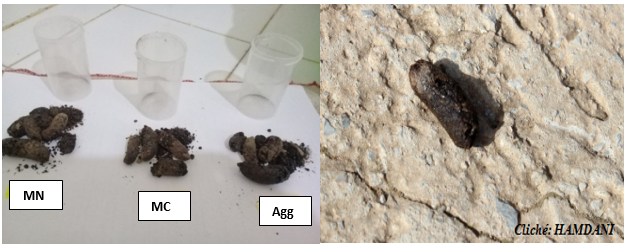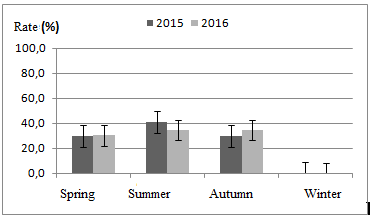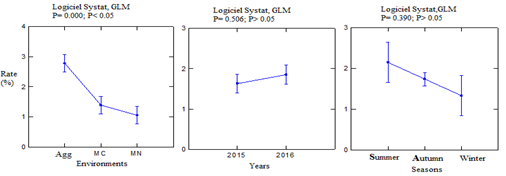


Bio-Ecological Study of the Berber Toad Amietophrynus mauritanicus (Anura: Bufonidae), in the K’sob Perimeter, M’Sila – Algeria
Mourad Hamdani 1,2*, Mahdi Sellami 2
1Department of Agricultural Sciences, Faculty of Sciences, Mohamed Boudiaf University. 28000. M'sila, Algeria.
2 Department of Agricultural and Forestry Zoology, ENSA, 16000. Algiers, Algeria.
ABSTRACT
Our study is on the Spatio-temporal distribution of the Berber Toad Amietophrynus mauritanicus (Anura: Bufonidae), in the perimeter of the K'sob (35° 43° 21° North 4° 33° 35° East), which is located on the northern side of the wilaya of M'Sila, at an altitude of 490 m. This study aims to have a general overview of the ecology of the species in a semi-arid bioclimate, case of the K'sob perimeter in the wilaya of M'Sila. The study of the spatio-temporal distribution of the Berber Toad Amietophrynus mauritanicus, during the years 2015 and 2016, consists of monthly outings to three selected environments (agglomeration, cultivated environment, and natural environment). The results show the abundance of the Berber toad in the summer period followed by autumn and spring (37.8%, 32.1%, and 30.1%, respectively). While in winter, nothing was recorded for this species of toad. However, the Berber toad is abundant, in spring, in both natural (66.7% - 38.5%) and cultivated environments (41.7% - 46.2%). In the Agglomerations, the rates are high during the summer (42.3% - 37.5%) and autumn (42.3% - 45.8%). It is concluded that the rates of the Berber toad in the K'sob perimeter vary in the three environments according to the seasons except in winter.
Keywords: Amietophrynus mauritanicus, Bioclimate, Berber toad, selected environments, spatio-temporal
The first elements of the knowledge of the herpetological fauna of the Maghreb appeared at the end of the first half of the 19th century with the first notes of Gervais (1836, 1844). Doumergue (1901) publishes a very interesting work "Essai sur la faune herpétologiste de l'Oranie", which remains a reference for many species, and in which several notes on the whole of Algeria and later Gauthier (1967) (Béni Abbés region) are included. In 1996, Schleich et al. reported the presence of 132 species in North Africa: 102 are present in Morocco (Harouak et al., 2019), 92 in Algeria, 62 in Tunisia as well as Libya and 43 in Egypt. Among the herpetological classes, amphibians or batrachians have been the object of several research works in the world, concerning both the systematic aspect of Dubois and that of biogeography, ecology, and developmental biology (Vieites et al., 2009). However, these amphibian populations are threatened by habitat loss, climate change, overexploitation of natural resources, introduction of invasive species, and various diseases (Vieites et al., 2009;Pyšek and Richardson, 2010). Knowledge of the ecology and status of Algerian amphibians is limited, while their natural environments are under anthropogenic pressure, which is intensifying under the effect of climate change (Samraoui et al., 2012; Bounar et al., 2018; Kebaili et al., 2019). The consequences of the decline caused by this threat affect the upper and lower trophic levels, as amphibians occupy a key place in the terrestrial and aquatic ecosystem. Information on their role in the food chain underscores their importance in food webs. Amphibians find most of their food in groups ofinsects that can cause serious damage to crop plants on the one hand and serve as prey for other animals on the other hand (Hutchins et al., 2003). Among the amphibians, typical of North Africa, the Berber Toad, Amietophrynus mauritanicus (Joger, 2003) is widespread in all Maghreb countries (Bons and Geniez, 1996; Schleich et al., 1996). In Algeria, in order to assess the ecological, distribution, and trophic behavior of this amphibian, data on its ecology, distribution, and trophic behavior are crucially lacking (Benzineb et al., 2019). In this sense, the present study provides the first data on the spatio-temporal distribution of the species Amietophrynus mauritanicus in Algeria and particularly in the M'Sila region, a steppe region in eastern Algeria
This part includes the choice and description of the study station, the techniques used in the field and in the laboratory, and the methods adopted to exploit the results.
The present work deals with the spatio-temporal distribution of the Berber Toad Amietophrynus mauritanicus in the perimeter of the K'sob (35° 43’ 21’’ North 4° 33’ 35’’ East),which is located onthe northern side of the wilaya of M'sila, at an altitude of 490 m. The choice of the site of the present study is in order to have a general overview of the ecology of the species and according to the accessibility, the security of the site, as well as the presence of animal and plant material. (figure 01).

Figure 01. (a) Hodna watershed, (b) Hodna watershed and K'Sob sub-basin, (c) K'Sob sub-basin
The study was carried out in the K'sob perimeter on the spatio-temporal distribution of the Berber Toad Amietophrynus mauritanicus, during the years 2015-2016, and consists of monthly field trips to three selected environments (Agglomeration (Agg), cultivated environment (MC), and natural environments (MN)). Since it is difficult to directly observe the species with nocturnal activity through the use of binoculars, telescopes, etc., droppings were collected in each site to monitor the spatio-temporal distribution of the species. The droppings of the Berber Toad can be recognized by their cylindrical and elongated shapes. They are brown (light) and sometimes blackish. The length of the droppings varies between 1.9 and 3.9 cm, with an average of 3.24 cm. The width of the droppings varies between 0.9 and 1.8 cm, with an average of 0.95. The minimum weight of dung is 0.4 g and the maximum value is 4.8 g (Figure 02).

Figure 02. Droppings of the Berber Toad (Amietophrynusmauritanicus)
The data analysis and graphical representations were carried out using the software "SYSTAT to. 12, SPSS 2009 and Excel TM". In cases where more than one factor is involved, not all interactions between factors may be relevant to the test. We then used the Global Linear Model (G.L.M) at a significance level of α =5%.
In order to establish a bio-ecological mapping of the inventoried species, the Berber Toad (Amietophrynusmauritanicus), we monitored the presence of this speciesin three different environments within the perimeter of the k'sob (agglomeration, cultivated, and natural environment) during the years 2015 and 2016.
According to Figure 03, the results show the abondance of Berber toad during the summer periodfollowed by fall and then spring (37.8%, 32.1%, and 30.1%, respectively). Whereas in winter, nothing was recorded for this species of toad.

Figure 03. Seasonal distribution of the Berber toad during the years 2015 and 2016.
Figure 04 shows the abundance of the Berber toad in the natural environment (66.7% - 38.5%) and the cultivated environment (41.7% - 46.2%) in spring. Inthe Agglomerations, the rates are high during the Summer (42.3% - 37.5%) and Autumn (42.3% - 45.8%).

Figure 04. Spatial distribution of the Berber toad in the three environments. Agglomeration (Agg), cultivated (MC) and natural (MN) environments
The statistical analysis performed by the G.L.M. model applied to the spatial and temporal distribution of the Berber toad reveals very highly significant differences between the three study environments; the probability is (p=0.000; p<0.05). However, differencesare non-significant for seasons and years (Figure 05). The abundance of the species studied varies significantly between environments (p=0.000; p<0.05). The highest rate is recorded in urban areas followed by the cultivated environment, while the lowest rate is recorded in the natural environment.

Figure 05. Spatial and temporal distribution of the Berber toad through variance analysis. Agglomeration (Agg), cultivated environment (MC), and natural environment (MN)
Study of the seasonal variation of bufo (Amietophrynus) mauritanicus in the k'sob perimeter, during the years 2015 and 2016, revealed the abundance of the Berber toad in the summer period followed by autumn and spring. Our results confirm those reported by Salvador (1996), who noted that the Berber Toad reproduces during the period from October to April; the Berber Toad mates in the aquatic environment. Whereas, Pujol (1985) and Pujol & Exbrayat (1996; 2001) have shown that in a semi-arid zone, this species is ready to breed throughout the year with rainfall being the trigger for reproduction. Our results also show the absence of traces of this species of toad bufo Summer and Autumn in the Agglomerations. According to Schleich et al. (1996), Amietophrynus mauritanicus in winter, which is a poikilothermic animal presents most of the winter in a slowed life stage, resulting in complete immobility. They take shelter under the ground, under a stump or a stone, or even at the bottom of the water in the mud (Grosselet et al., 2001). The distribution of bufo (Amietophrynus) mauritanicus in the three study environments reveals the abundance of the Berber toad in the natural and cultivated environment in spring. According to El Hamoumi et al. (2007), the Berber Toad is the only species that frequents flowing waters, often with high abundances in shallow areas of warm, vegetated rivers. Although, this species of toad prefers forests, it is found in all types of terrain: steppes,mountains, wadis, oases, dam banks, hotel lawns, beaches, campground toilets, etc. It is found in mountain ranges, oases, and even far from water (LE Berre, 1989). The statistical analysis performed by the G.L.M. model applied to the spatial and temporal distribution of the Berber toad shows very highly significant differences between the three study environments. The highest rate is recorded in the urban areas followed by the cultivated environment, while the low rate is recorded in the natural environment. These results are explained by Schleich et al. (1996), who reported the Berber Toad as a twilight and nocturnal animal with little activity during the day. Due to the North African climate, the Berber Toad lives in relatively dry areas, while always taking care to stay close to water points, even if only temporarily. Water is therefore not a permanent necessity, but must be accessible from time to time, for the reproduction and survival of the species.
This study has provided us with preliminary data, worth pursuing, on the spatial and temporal distribution of the Berber Toad Amietophrynus mauritanicus (Anura: Bufonidae), in the Ksob perimeter located in the M'Sila region classified in the semi-arid bioclimatic stage. Through these results, the Berber Toad Amietophrynus mauritanicus (Anura: Bufonidae) is abundant during the summer period followed by autumn and spring. Whereas in winter, nothing has been recorded for this species. On the other hand, the distribution of this species in the three chosen environments (agglomeration, cultivated and natural environment) of the K'sob perimeter reveals the abundance of the Berber toad in the natural environment, the cultivated environment in spring, and in the agglomerations during summer. Given the importance of amphibians, knowledge of ecology helps to protect these animals, which occupy a place in biological control because of their type of food based on groups of insects that can cause serious damage to cultivated plants on the one hand, and in the trophic chain serve as prey for other animals on the other hand.
REFERENCES
